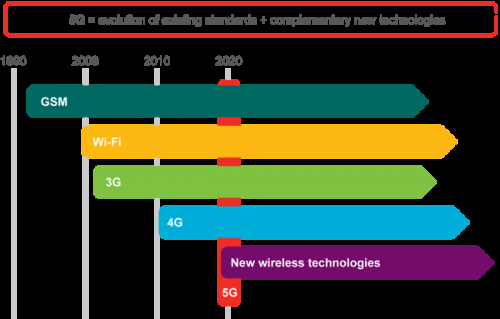July 3, 2014 weblog
Ericsson demo gets 5Gbps throughput in 15 GHz frequency band

As you may already know, trade shows and other big technology events are where a lot of dreaming takes place, rich with early prototypes and concept videos to interest viewers in what may or may not end up on shelves or be offered as services any time soon. Blogger Dominic Basulto back in February in The Washington Post provided some interesting observations about the keen interest shown at the 2014 Mobile World Congress in Barcelona on 5G networks. He said the future of 5G was one of the hottest topics of discussion. He described 5G as a next generation mobile communications network to offer exponential gains over 4G networks in speed and capacity. Well, 5G implementation in commercial mobile networks is expected in 2020, but on Tuesday the Stockholm-based communications technology and services. company Ericsson took everyone closer to 5G dreaming with its announcement that it achieved speeds of 5 Gbps in a demonstration. This was described as-the company's pre-standard 5G network technology. "This proven performance will be critical to addressing both the relentless growth in mobile data demand and enabling the next-generation machine-to-machine applications," said the company.
How did they get their results? The demonstration, said Ericsson, used a new "radio interface concept" and advanced Multiple-Input Multiple-Output (MIMO) technology.
At Ericsson, 5G network development activity has involved antenna technologies with wider bandwidths, higher frequencies and shorter transmission time intervals. What is more, radio base stations built with baseband units and radio units are under development specifically for 5G trials. Ericsson said more key focus areas are small cells in a heterogeneous network environment; new frequency bands including 15 GHz; and high-speed, high-capacity backhaul transmission.
NTT DOCOMO and SK Telecom senior management witnessed Ericsson's achievement at the Ericsson lab in Kista, Sweden. Johan Wiberg said: "5G will impact both the access and core of mobile networks so we are working closely with leading operators, including NTT DOCOMO and SK Telecom, to ensure a practical and proactive evolution. The development of advanced radio technologies is one of the first critical steps in the realization of a 5G future." Ericsson noted that 5G standards are still in early development; new spectrum allocations are still to be considered. Nonetheless, Ericsson's Tuesday announcement of its 5G demonstration shows its clear intent to excel at the finish line.
To be sure, 5G will support innovative product breakthroughs to come. As Basulto pointed out, to make all those machine to machine communications work in the Internet of Things, fast, high-capacity networks will be needed and 5G networks promise speeds much faster than anything that exists today. What is more, "In order to support a large number of driverless vehicles on highways, you need 5G networks and all the extra capacity they deliver."
Erik Dahlman, senior expert in Radio Access Technologies in Ericsson Research, gave a Tech Talk last year, where he said, "We see 5G as an enabler for the fully connected networked society. It is an enabler for a future world with unlimited access to information and sharing of data anywhere and anytime to anyone and anything. Thus, the networked society is not only about mobile telephony and mobile broadband; it is about wireless connectivity for any kind of application. It is not only about connectivity for people. It is about connectivity for any kind of device. The connectivity will be available truly anywhere and anytime."
Ericsson in the Tuesday announcement said, "It will also enable new device-to-device and M2M applications that will impact both consumers, such as traffic safety control, tactile internet, and industry, for example sensors or capillary networks." Ericsson said North America could be one of the first regions to adopt 5G and at the same time, Japan and South Korea are also likely to benefit from early 5G availability with trials already announced by NTT DOCOMO and SK Telecom.
Beyond the engineering feats behind 5G technologies, there are other reasons why 5G is being watched with interest. Basulto said in his 5G article that "the reason why Europe and Asia are committing so much attention to 5G is because of the potential to drive future economic growth." The arrival of 5G could drive new markets in healthcare, automotive transport and other industry sectors. The Ericsson Mobility Report forecasts a 10-time growth in mobile data traffic between 2013 and 2019 and highlights three to four times growth in the number of active cellular M2M devices by 2019.
More information:
— www.ericsson.com/news/1810070
— www.ericsson.com/news/131122-t … -talk-5g_244129226_c
© 2014 Tech Xplore




















